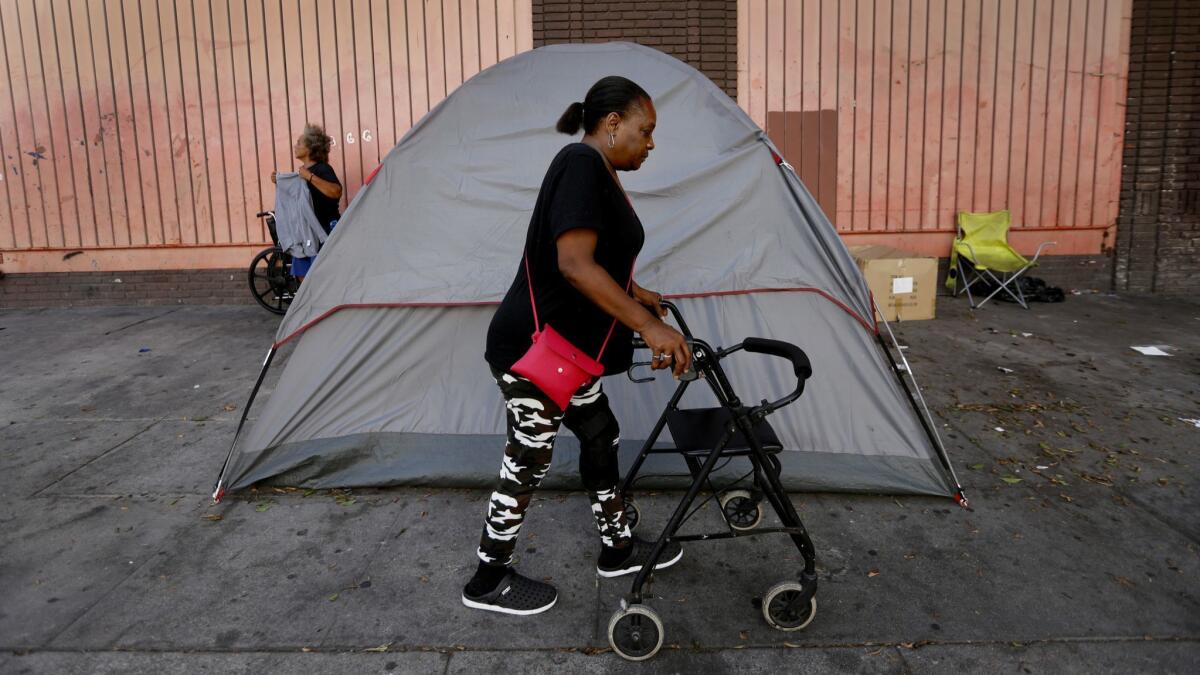A new study says it can predict homelessness. But L.A. County doesn’t want to use it

- Share via
Hoping to lower the cost of mitigating homelessness by preventing people from becoming homeless in the first place, a Los Angeles research group says it has created a screening tool that can predict who is likely to become chronically homeless after losing a job or leaving the foster-care system.
The Economic Roundtable published a report Wednesday, offering its statistical model as a way for Los Angeles County workers to target their resources early to keep people from sliding into long-term homelessness.
But county officials are declining to use it.
Instead, they have accused the Roundtable — a nonprofit that has conducted extensive studies on homelessness — of misusing millions of records from county and state agencies, including statistics on employment, healthcare and homelessness, as well as involvement in the criminal justice and foster care systems.
The Roundtable combined the government records and removed duplicate names and other identifying information. But county officials ordered the nonprofit to destroy the data and not to publish the resulting report.
In a Feb. 26 letter to the Roundtable, the county counsel’s office alleged that it had acquired the original records a decade or more ago under agreements that narrowly defined how the information would be used and set time limits that have long since expired for the records to be destroyed or returned.
The county, Principal Deputy County Counsel Truc L. Moore wrote, has a duty to protect state and county data, and “to report to the state any inconsistencies, if any, with the contractual requirements that all parties agreed to.”
L.A. promised more housing for homeless people — but some neighborhoods are way behind »
In a partial compromise last week, Roundtable President Dan Flaming agreed to destroy the original records. But he said he hopes to eventually publish his working files, which, he says, would be valuable to other researchers looking to review the findings and to pursue their own studies.
The report published Wednesday includes a table of factors that could be entered into a computer program and used by social services workers to calculate the odds that a client will become persistently — or chronically — homeless. The Roundtable defines “persistently homeless” as 12 consecutive months of homelessness, or two or more stints within three years.
In announcing the results Wednesday, Flaming said the statistical model can identify the 1% of unemployed workers most likely to become persistently homeless with 81% accuracy. For youth leaving the foster care system, the accuracy is 72%.
“It’s very difficult to see a path to housing all the homeless if we don’t use this information,” Flaming said.
The Roundtable, which made an unsuccessful bid for a contract with the county to analyze the annual homeless count data, has published several studies on homelessness and criticized the accuracy of numbers published by the Los Angeles Homeless Services Authority.
A 2013 study from the Roundtable found that homeless people who frequently cycle through the county hospital system use nearly four times the public resources that would be needed to house them, providing support for the argument for more locally funded housing programs.
In September, after releasing another report, Flaming said the Roundtable would soon publish a screening tool to help homeless services providers identify people who are likely to become persistently homeless. The tool would allow them to intervene early with individually designed packages of assistance, saving public funds in the long term.
But the dispute with the county caused him to delay its release in January.
The dispute surfaced in December after Flaming briefed Phil Ansell, director of the county’s Homeless Initiative. Max Stevens, with the county’s Chief Information Office, wrote Flaming a four-page letter ordering him to destroy the data and not publish the report.
Following negotiations with the Roundtable’s attorney, Brad Phillips of Munger Tolles & Olson, the county removed the prohibition on publishing the report but put the nonprofit on notice that it would publish it at its own risk.
Flaming said he agreed not use the data for 60 days to see if he could work out an agreement. In the meantime, the Roundtable has entrusted the data to a retired judge. If no agreement is reached, Flaming said, he will submit a public records request and its board would consider filing a lawsuit to make the data public.
Last week, The Times filed a public records request for the data.
The county has yet to respond.
“We would love to have the county use this tool,” Flaming said. “We would do anything we could to support that.”
County officials declined to comment Wednesday on the dispute over the data. In a statement, Chief Information Officer William S. Kehoe said the county “recognizes the importance of good data analysis to assist our efforts” but could not comment on the Roundtable’s report because “we do not know where the data came from, what methodology was used, or what research requirements and protocols were adhered to.”
In the meantime, Flaming is looking for other ways to put the data to work. The Los Angeles County Federation of Labor has expressed interest in using the algorithm to select candidates for a job training program, he said.
“That’s the test we have in our sights at this moment,” he said.
More to Read
Sign up for Essential California
The most important California stories and recommendations in your inbox every morning.
You may occasionally receive promotional content from the Los Angeles Times.











